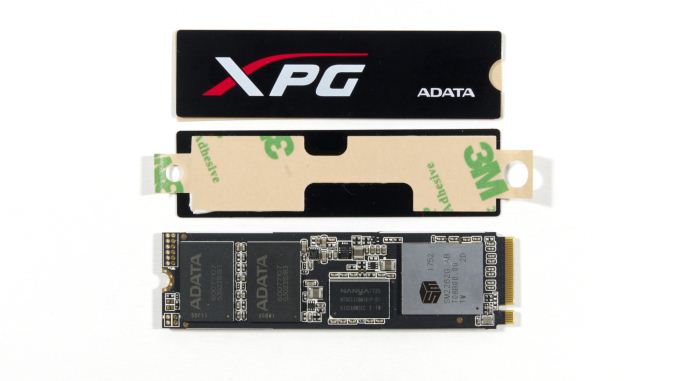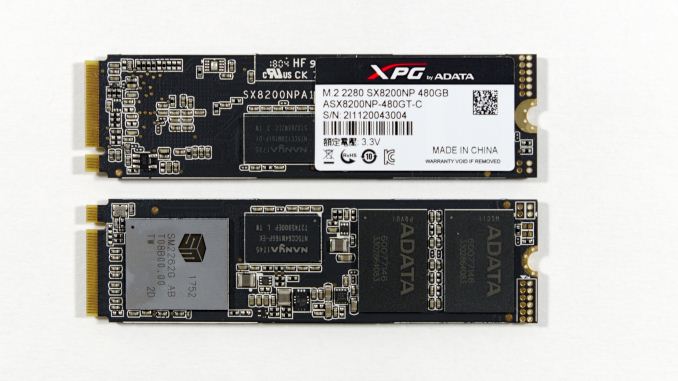
Original Link: https://www.anandtech.com/show/13112/the-adata-sx8200-gammix-s11-nvme-ssd-review
The ADATA XPG SX8200 & GAMMIX S11 NVMe SSD Review: High Performance At All Sizes
by Billy Tallis on July 25, 2018 11:00 AM EST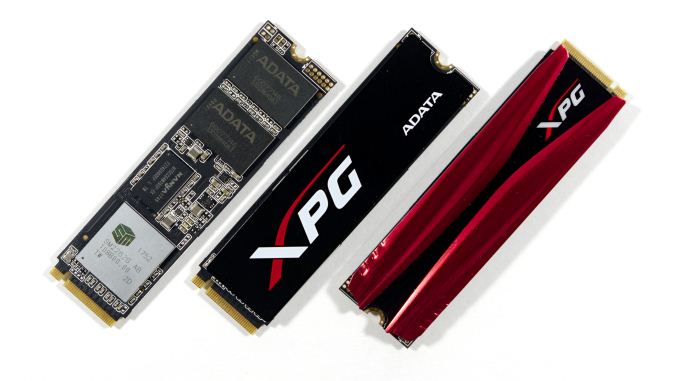
ADATA has a very broad portfolio of consumer NVMe SSDs, featuring most of the controller solutions available on the open market. Not all of these have been particularly successful, but the most recently released drives use a formula that has been working well for several other players in the SSD market: Silicon Motion's SM2262 controller combined with Intel/Micron 64-layer 3D TLC NAND flash memory. The ADATA XPG SX8200 and GAMMIX S11 SSDs differ primarily in branding and the design of their heatspreaders, but underneath they both feature the same SSD architecture that we've found makes for a great combination of high performance and reasonable prices.
The SX8200 and GAMMIX S11 replace several older ADATA SSDs that used Silicon Motion's first NVMe SSD controller, the SM2260. The XPG SX8000 paired that controller with Micron's 32-layer 3D MLC NAND, while the XPG SX7000 and GAMMIX S10 used Micron's 32-layer 3D TLC NAND. Those first-generation NVMe drives from ADATA suffered from the limitations of the SM2260 controller and the first-generation 3D NAND from Intel and Micron. As a result, even the use of MLC NAND in the SX8000 couldn't enable it to reach the performance of good TLC-based SSDs like the Samsung 960 EVO. The SX7000 and GAMMIX S10 were even worse off and despite ADATA's branding (and pricing) them like high-end SSDs, they were among the slowest NVMe SSDs on the market and could not reliably outperform mainstream SATA SSDs.
| ADATA Consumer NVMe SSD Comparison | |||
| Model | XPG SX8200, XPG GAMMIX S11 |
XPG SX8000 | XPG SX7000, XPG GAMMIX S10 |
| Capacities | 240–960GB | 128GB–1TB | 128GB–1TB |
| Controller | Silicon Motion SM2262 | Silicon Motion SM2260 | |
| NAND Flash | Micron 64L 3D TLC | Micron 32L 3D MLC | Micron 32L 3D TLC |
| Form-Factor | double-sided M.2-2280, PCIe 3.0 x4 | ||
| Protocol | NVMe 1.3 | NVMe 1.2 | |
| Sequential Read | 3150–3200 MB/s | 1000–2400 MB/s | 660-1750 MB/s |
| Sequential Write | 1100–1700 MB/s | 300–1000 MB/s | 450-860 MB/s |
| Random Read | 200k–310k IOPS | 45k-100k IOPS | 35k-130k IOPS |
| Random Write | 240k–280k IOPS | 75k-140k IOPS | 95k-140k IOPS |
| Warranty | 5 years | ||
| Write Endurance | 0.37 DWPD | 0.34 DWPD | 0.34 DWPD |
| Announced | March 2018 (SX8200) April 2018 (S11) |
September 2016 | April 2017 (SX7000) July 2017 (S10) |
ADATA has also released or announced several other consumer NVMe SSDs that aren't included in the chart above. The SX6000 and SX7100 use Realtek controllers and the SX9000 uses a Marvell controller. The Silicon Motion-based drives occupy the middle of the lineup and are the most popular and widely available NVMe drives from ADATA.
This year, most of the SSD industry is working with 64-layer 3D NAND (almost exclusively TLC NAND), and there's no clear winner or loser in raw NAND performance this time around. Silicon Motion's second-generation NVMe controllers are capable of delivering far higher performance than the disappointing SM2260, and the market for high-end SSDs is no longer dominated exclusively by Samsung.
Intel was first to market with the SM2262 controller in the 760p SSD, which features some Intel-specific customizations to the Silicon Motion reference design. The ADATA XPG SX8200 and GAMMIX S11 are much closer to the reference design, but use NAND that has been binned and packaged by ADATA, and come with ADATA's own heatspreader designs. The other SM2262 drive we've reviewed is the 1TB HP EX920. Compared to the EX920, the ADATA drives have lower usable capacities due to reserving more spare area, which usually improves sustained write performance. Today's review focuses on 240GB and 480GB models from ADATA, which gives us a chance to see what performance is like at the more affordable end of the product line. We can also compare the performance of the SX8200 with no heatspreader against the GAMMIX S11 with a heatspreader (and with slightly newer firmware). Spoiler: those differences never matter to real-world usage. For all practical purposes, the SX8200 and GAMMIX S11 are just cosmetically different.
| ADATA XPG SX8200 and GAMMIX S11 Specifications | |||||
| Capacity | 240 GB | 480 GB | 960 GB | ||
| Controller | Silicon Motion SM2262 | ||||
| NAND Flash | Micron 64L 3D TLC | ||||
| Form-Factor, Interface | M.2-2280, PCIe 3.0 x4, NVMe 1.3 | ||||
| Sequential Read | 3200 MB/s | 3200 MB/s | 3150 MB/s | ||
| Sequential Write | 1100 MB/s | 1700 MB/s | 1700 MB/s | ||
| Random Read IOPS | 200K IOPS | 310K IOPS | 310k IOPS | ||
| Random Write IOPS | 240K IOPS | 280K IOPS | 280k IOPS | ||
| Warranty | 5 years | ||||
| Write Endurance | 160 TB 0.37 DWPD |
320 TB 0.37 DWPD |
640 TB 0.37 DWPD |
||
| Current Retail Price |
SX8200 | $91.93 (38¢/GB) | $139.99 (29¢/GB) | $284.99 (30¢/GB) | |
| S11 | $84.99 (35¢/GB) | $159.99 (33¢/GB) | $299.99 (31¢/GB) | ||
ADATA's performance specifications for the SX8200 and GAMMIX S11 show that the 240GB models are significantly handicapped for all access patterns other than sequential reads. Even so, that smallest SX8200 is rated to easily outperform the largest and fastest model from the preceding SX8000 family. With the move to higher-density 3D NAND, ADATA has dropped the 128GB capacities from the lineup. Performance at that capacity would be even lower than what the 240GB models provide, and would no longer be reasonable for a high-end NVMe SSD. ADATA's low-end SX7100 series is planned to retain a 120GB option. ADATA has not yet brought a 2TB M.2 NVMe SSD to market, but they are prepared to extend the SX8200 family to a 1.92TB (usable capacity) model.
Write endurance for the SX8200 and GAMMIX S11 is rated for a little over the typical 0.3 drive writes per day, and the five year warranty period is standard for high-end SSDs. The PCB used by the SX8200 and GAMMIX S11 has components on both sides at all capacities, so even without the heatspreaders these drives won't fit into every notebook computer.
The ADATA XPG GAMMIX S11 comes with the same two-tone textured heatspreader that was used on the GAMMIX S10. The thermal pads anchor the red parts of the heatspreader to the chips below while the black recessed area does not make contact with the drive. The ADATA XPG SX8200 comes with a flat black heatspreader ready to be installed and a thermal pad that makes full contact with the controller, DRAM and NAND packages on the top side of the drive. For this review, the SX8200s were tested without the heatspreaders installed.
In addition to comparing the SX8200 and GAMMIX S11 against their immediate predecessors from ADATA, this review compares them against the following competitors:
- The 1TB HP EX920, as an example of a higher-capacity SSD with essentially the same internals
- An assortment of Samsung NVMe SSDs that generally represent the gold standard for high-performance high-price SSDs.
- The Intel Optane SSD 900P and 800P, the most expensive consumer SSDs, with absolutely unbeatable performance in some areas, but not the fastest in every category.
- The Intel SSD 760p, very similar to the SX8200 or HP EX920 save for some customizations that Intel hasn't detailed.
- The second-generation Western Digital WD Black, a top of the line TLC-based SSD with a new in-house controller that poses the most direct threat Samsung's 9x0 EVO SSDs have faced so far.
| AnandTech 2018 Consumer SSD Testbed | |
| CPU | Intel Xeon E3 1240 v5 |
| Motherboard | ASRock Fatal1ty E3V5 Performance Gaming/OC |
| Chipset | Intel C232 |
| Memory | 4x 8GB G.SKILL Ripjaws DDR4-2400 CL15 |
| Graphics | AMD Radeon HD 5450, 1920x1200@60Hz |
| Software | Windows 10 x64, version 1709 |
| Linux kernel version 4.14, fio version 3.6 | |
| Spectre/Meltdown microcode and OS patches current as of May 2018 | |
- Thanks to Intel for the Xeon E3 1240 v5 CPU
- Thanks to ASRock for the E3V5 Performance Gaming/OC
- Thanks to G.SKILL for the Ripjaws DDR4-2400 RAM
- Thanks to Corsair for the RM750 power supply, Carbide 200R case, and Hydro H60 CPU cooler
- Thanks to Quarch for the XLC Programmable Power Module and accessories
- Thanks to StarTech for providing a RK2236BKF 22U rack cabinet.
AnandTech Storage Bench - The Destroyer
The Destroyer is an extremely long test replicating the access patterns of very IO-intensive desktop usage. A detailed breakdown can be found in this article. Like real-world usage, the drives do get the occasional break that allows for some background garbage collection and flushing caches, but those idle times are limited to 25ms so that it doesn't take all week to run the test. These AnandTech Storage Bench (ATSB) tests do not involve running the actual applications that generated the workloads, so the scores are relatively insensitive to changes in CPU performance and RAM from our new testbed, but the jump to a newer version of Windows and the newer storage drivers can have an impact.
We quantify performance on this test by reporting the drive's average data throughput, the average latency of the I/O operations, and the total energy used by the drive over the course of the test.
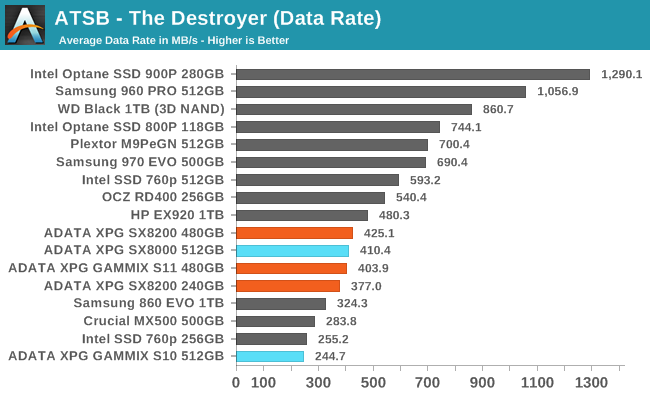
The performance of the ADATA drives on The Destroyer is about as expected given how the other SM2262 drives behave: The average data rates are significantly lower than most of the other recent high-end SSDs. The SX8200 and GAMMIX S11 with 64L 3D TLC and a newer controller perform about as well as the older SX8000 with 32L MLC and the slower SM2260 controller, while the older TLC-based GAMMIX S10 sits at the bottom of the chart. It is interesting that the Intel 760p with very similar hardware shows much greater variation in performance between capacities than the SX8200. Whatever customizations Intel has made to the SM2262 platform are helping their 512GB model but hurting the 256GB model.
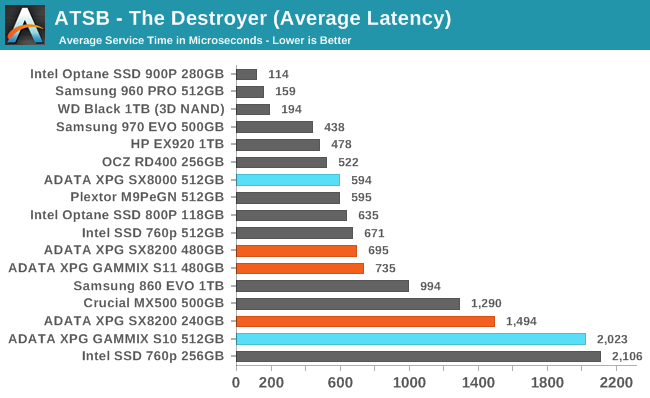
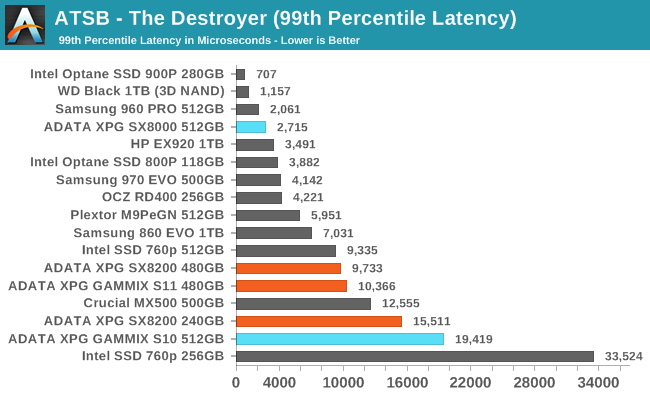
The SX8200 and GAMMIX S11 can't match the latency of the MLC-based SX8000 on The Destroyer, with a small disadvantage in average latency and much worse 99th percentile latency. Compared to the previous-generation TLC drive, things are greatly improved to the point that the 240GB SX8200 has lower latency than the 512GB GAMMIX S10.
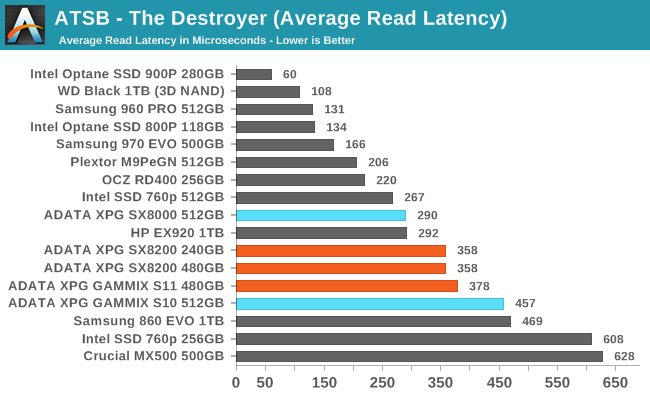
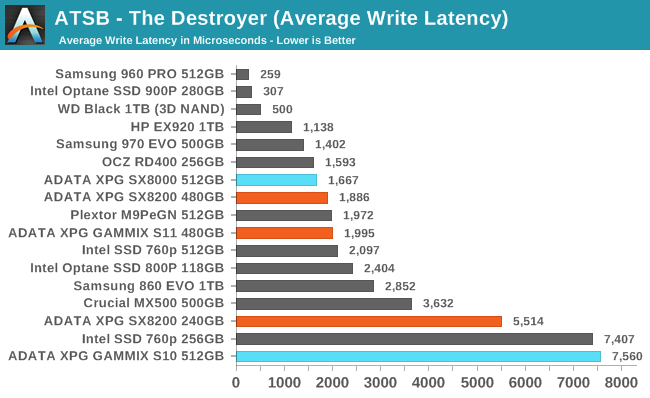
Differences in drive capacity seem to have a much bigger effect on the SX8200's average write latency than the average read latency. However, it's on the read side that the latency of the SX8200 stands out as clearly worse than other current competitors like the Samsung 970 EVO. The poor write latency of the TLC-based GAMMIX S10 has been thoroughly addressed by the new drives, with a factor of four improvement.
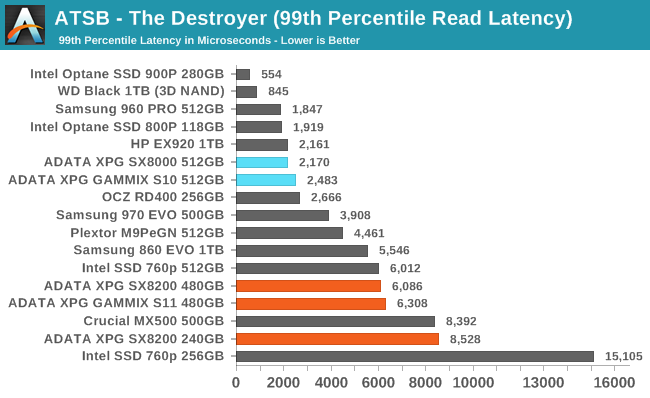
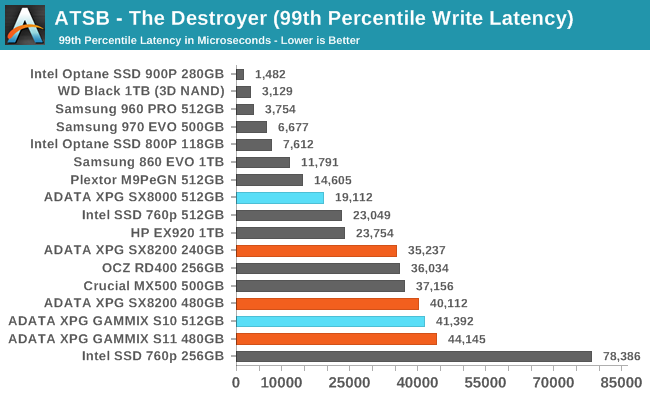
The older SM2260 SSDs with MLC or TLC have much better 99th percentile read latencies than the newer ADATA drives with the SM2262 controller. Average latency for the TLC-based drives is vastly better with the newer generation, but some consistency has been sacrificed. The 99th percentile write latency hasn't changed much, and the MLC-based SX8000 still has a clear advantage there despite using the older controller and NAND.
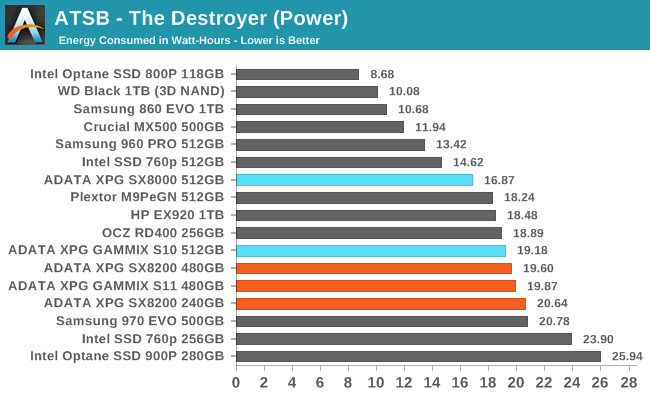
The SX8200 and GAMMIX S11 use a bit more energy than their predecessors to complete The Destroyer, but this isn't too surprising–it's often necessary to sacrifice some efficiency to get better performance, and The Destroyer is quite a bit more intense than the workloads that the newer ADATA drives are optimized for.
AnandTech Storage Bench - Heavy
Our Heavy storage benchmark is proportionally more write-heavy than The Destroyer, but much shorter overall. The total writes in the Heavy test aren't enough to fill the drive, so performance never drops down to steady state. This test is far more representative of a power user's day to day usage, and is heavily influenced by the drive's peak performance. The Heavy workload test details can be found here. This test is run twice, once on a freshly erased drive and once after filling the drive with sequential writes.
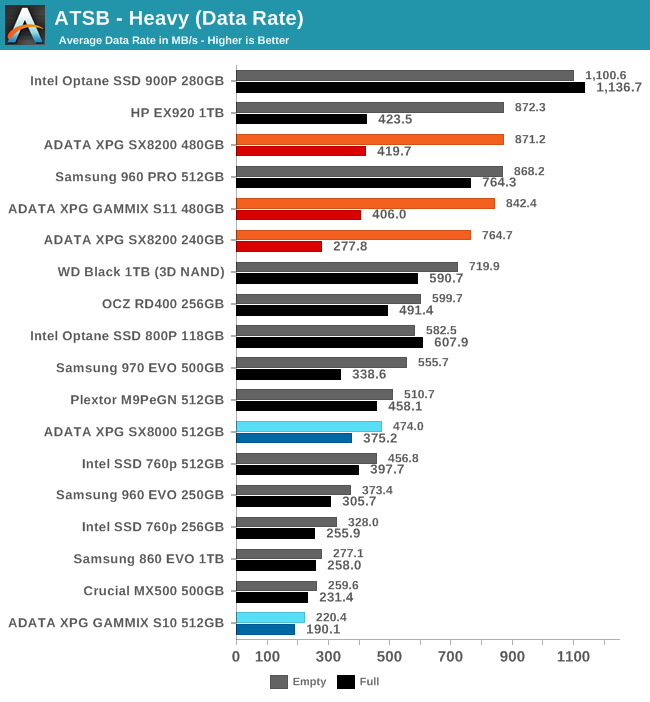
When running the Heavy test on freshly-erased drives, the average data rates from the ADATA SX8200 and GAMMIX S11 are excellent, and a huge improvement over their predecessors. Performance varies relatively little with capacity, with the 480GB drives delivering essentially the same speeds as the 1TB HP EX920, and the 240GB SX8200 is only slower by about 12%. The catch is that these drives using the SM2262 controller lose most of their performance advantage when the test is run on a full drive.

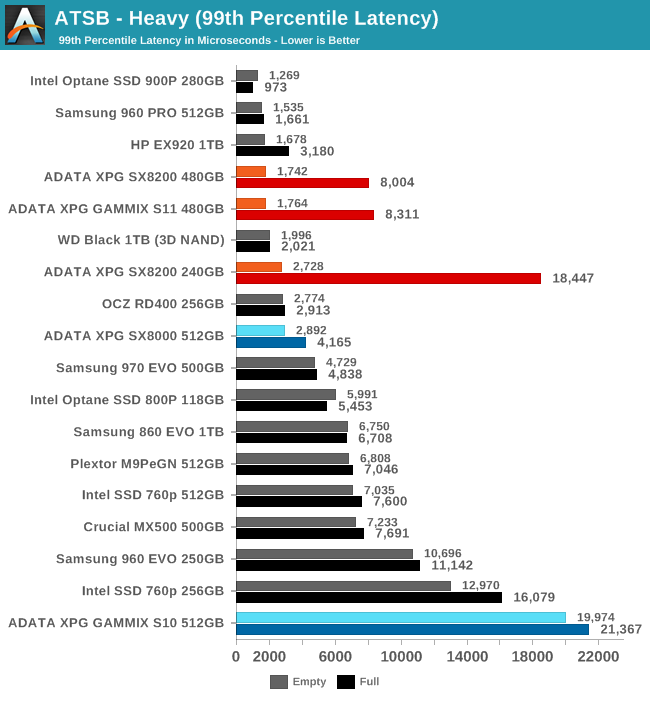
The average latencies from the latest ADATA drives are great when the test is run on an empty drive, but are on par with the competition when the drives are full. The 99th percentile latencies for the full-drive test runs are generally worse than the current-generation competition.
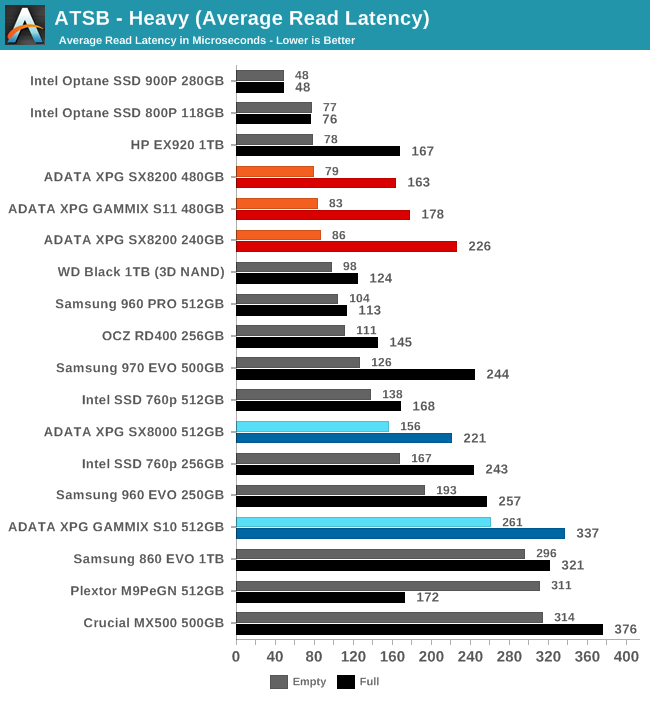
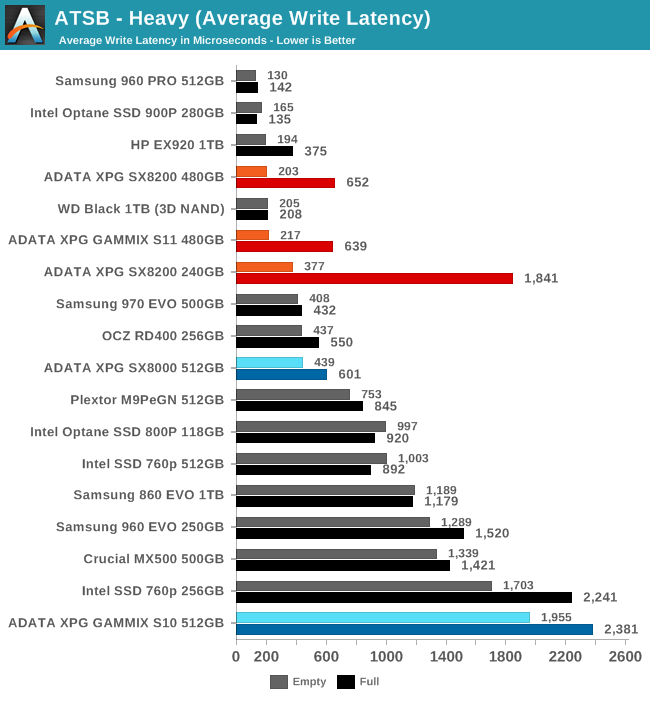
The average write latencies of the SX8200 and GAMMIX S11 highlight what seems to be the most significant weakness of this drive architecture, with full-drive performance drops that are far larger than is typical for high-end SSDs. The average read latencies also show a large performance drop, but the SX8200 and GAMMIX S11 started out with a decent lead in the empty drive test runs so this doesn't cause much trouble.
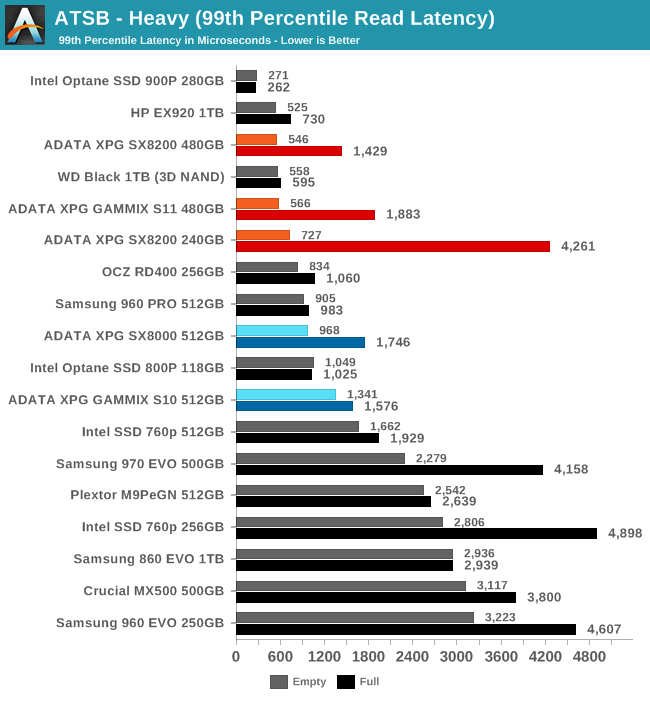
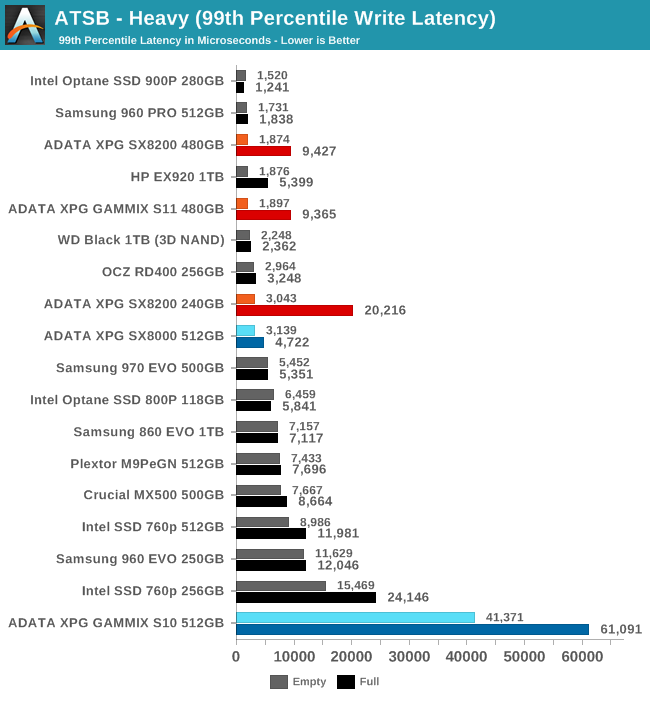
When looking at 99th percentile latency, both read and write operations suffer remarkably on the SM2262 drives when the test is run on a full drive. The 1TB HP EX920 is least affected, but the smaller ADATA drives have a real problem as their full-drive latency can be worse than mainstream SATA drives.

Only the smallest SX8200 stands out in the energy usage results. The larger models have fairly typical power efficiency for both the empty and full drive test runs, but the 240GB SX8200 loses a lot of performance when full and burns a lot more energy on background garbage collection.
AnandTech Storage Bench - Light
Our Light storage test has relatively more sequential accesses and lower queue depths than The Destroyer or the Heavy test, and it's by far the shortest test overall. It's based largely on applications that aren't highly dependent on storage performance, so this is a test more of application launch times and file load times. This test can be seen as the sum of all the little delays in daily usage, but with the idle times trimmed to 25ms it takes less than half an hour to run. Details of the Light test can be found here. As with the ATSB Heavy test, this test is run with the drive both freshly erased and empty, and after filling the drive with sequential writes.
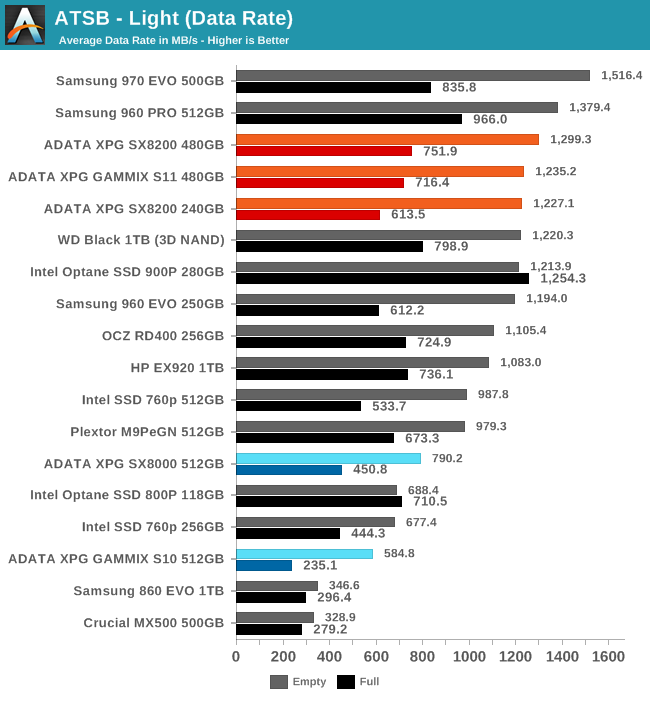
As with the Heavy test, the freshly-erased ADATA SX8200 and GAMMIX S11 deliver great average data rates on the Light test. It isn't quite class-leading performance, but it comes reasonably close, even for the smallest 240GB SX8200. Full-drive performance continues to be much lower, but on this test the performance loss isn't much larger than what other top TLC-based SSDs suffer from.
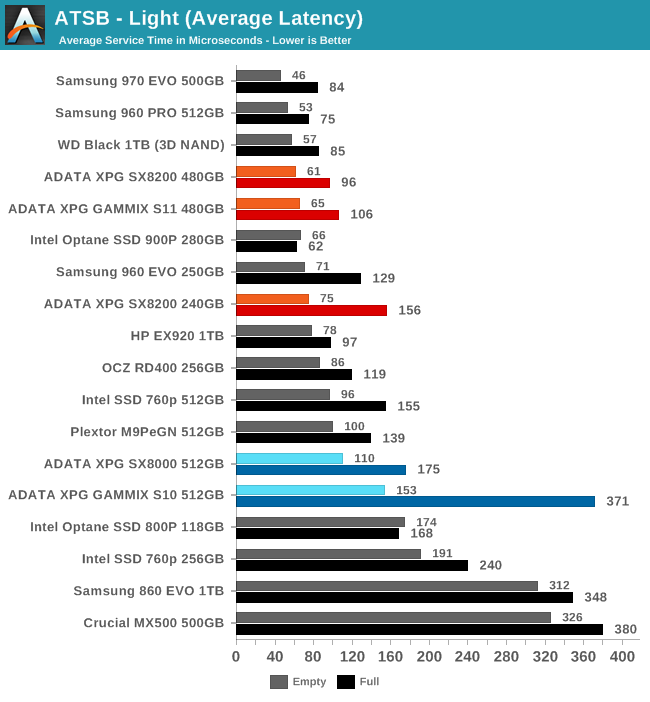

The 99th percentile latency of the 240GB SX8200 is a bit high when the Light test is run on a full drive, but otherwise the latency scores are pretty good. The 480GB SX8200 and GAMMIX S11 have far lower latency on the Light test than either the MLC-based SX8000 or TLC-based GAMMIX S10.
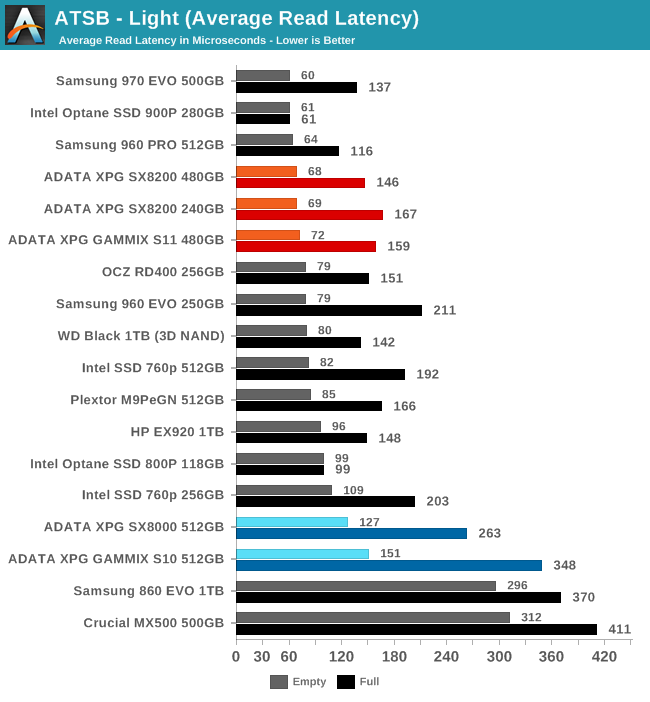
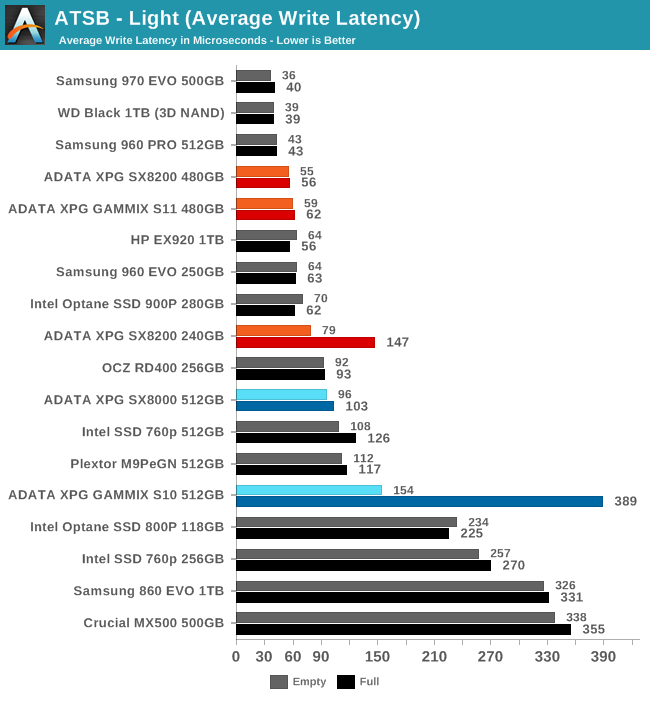
The average read latency scores from the older generation of ADATA NVMe drives weren't bad, but the new generation's scores are excellent. The average write latency scores are also very good, and even the significantly higher latency of the 240GB SX8200's full-drive test run is much better than SATA performance.
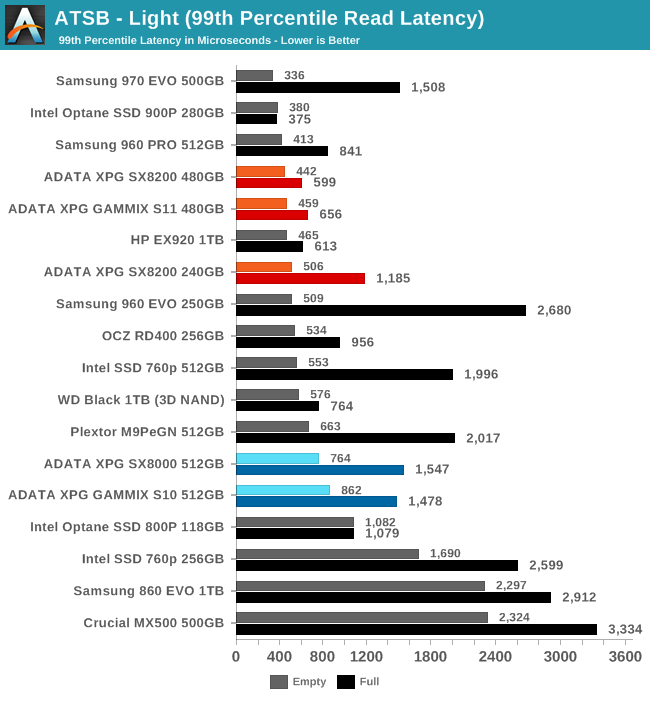
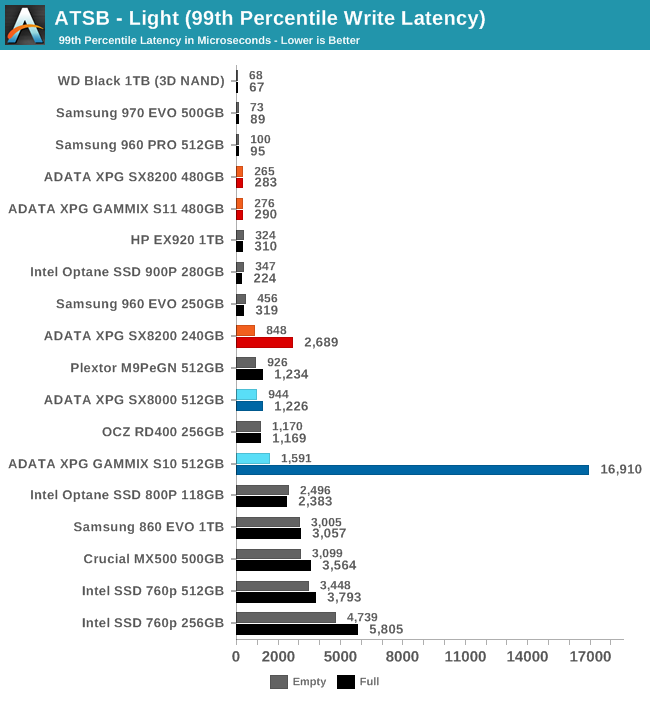
The 99th percentile read and write latency scores from the newer ADATA drives are very good, and the 99th percentile write latency in particular is far better for the 480GB drives than for their predecessors.
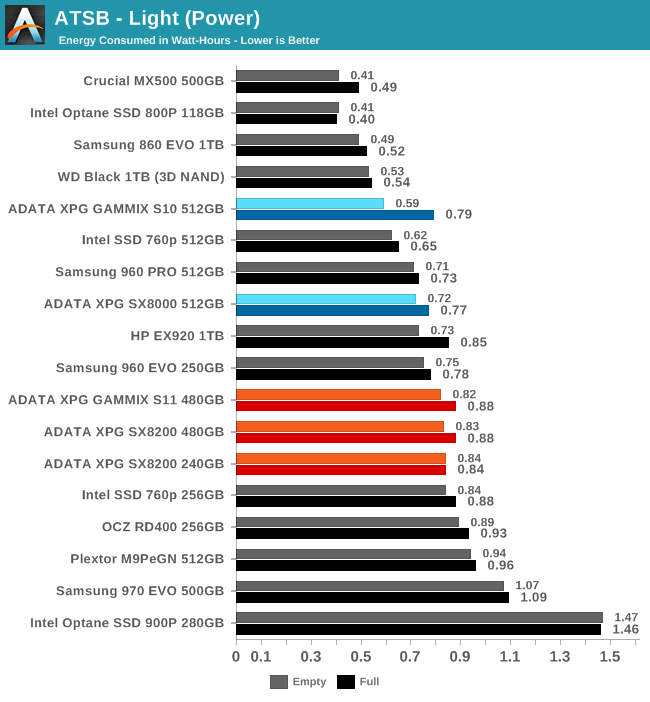
Power efficiency isn't a strong point for the ADATA SX8200 and GAMMIX S11, but their energy usage numbers aren't embarrassing: they're still well below the Samsung 970 EVO, though the older (slower) ADATA drives used a bit less energy and the best current NVMe drives are able to compete with SATA drives for efficiency.
Random Read Performance
Our first test of random read performance uses very short bursts of operations issued one at a time with no queuing. The drives are given enough idle time between bursts to yield an overall duty cycle of 20%, so thermal throttling is impossible. Each burst consists of a total of 32MB of 4kB random reads, from a 16GB span of the disk. The total data read is 1GB.

The burst random write performance of the ADATA SX8200 and GAMMIX S11 is excellent. The GAMMIX S11 is slightly faster than the SX8200, and they all clearly have very quick write caches.
Our sustained random read performance is similar to the random read test from our 2015 test suite: queue depths from 1 to 32 are tested, and the average performance and power efficiency across QD1, QD2 and QD4 are reported as the primary scores. Each queue depth is tested for one minute or 32GB of data transferred, whichever is shorter. After each queue depth is tested, the drive is given up to one minute to cool off so that the higher queue depths are unlikely to be affected by accumulated heat build-up. The individual read operations are again 4kB, and cover a 64GB span of the drive.
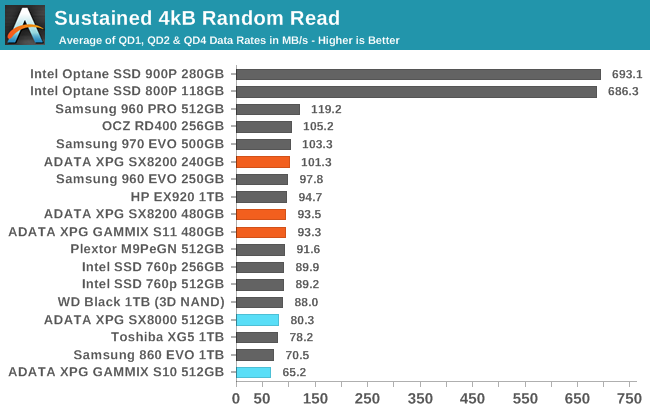
On the longer random read test, the newer ADATA drives aren't quite as close to the top of the charts, but they are still performing very well and are far faster than their predecessors.
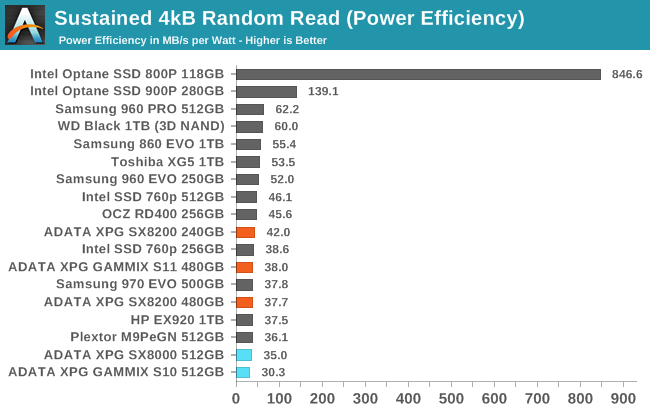 |
|||||||||
| Power Efficiency in MB/s/W | Average Power in W | ||||||||
The SX8200 and GAMMIX S11 use more power than their predecessors and most competitors on the sustained random read test, but their performance is high enough that the efficiency scores end up only a bit below average for flash-based SSDs.
 |
|||||||||
The SX8200 gains very little performance from QD1 to QD2, but then scales up reasonably well as queue depths increase. By QD32, only the smallest 240GB SX8200 seems to be starting to level off.
Random Write Performance
Our test of random write burst performance is structured similarly to the random read burst test, but each burst is only 4MB and the total test length is 128MB. The 4kB random write operations are distributed over a 16GB span of the drive, and the operations are issued one at a time with no queuing.
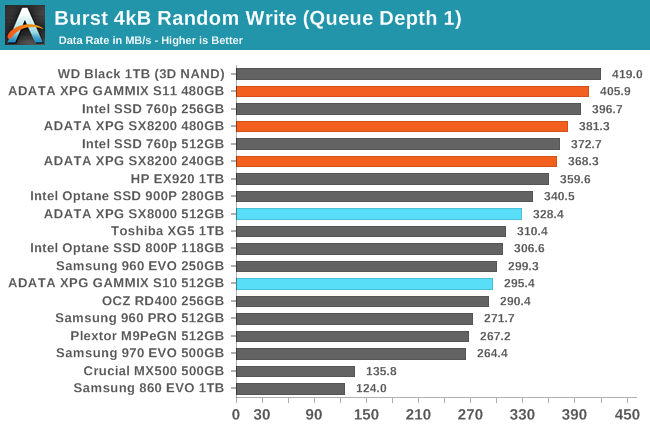
The burst random write performance of the ADATA SX8200 and GAMMIX S11 is excellent. The GAMMIX S11 is slightly faster than the SX8200, and they all clearly have very quick write caches.
As with the sustained random read test, our sustained 4kB random write test runs for up to one minute or 32GB per queue depth, covering a 64GB span of the drive and giving the drive up to 1 minute of idle time between queue depths to allow for write caches to be flushed and for the drive to cool down.
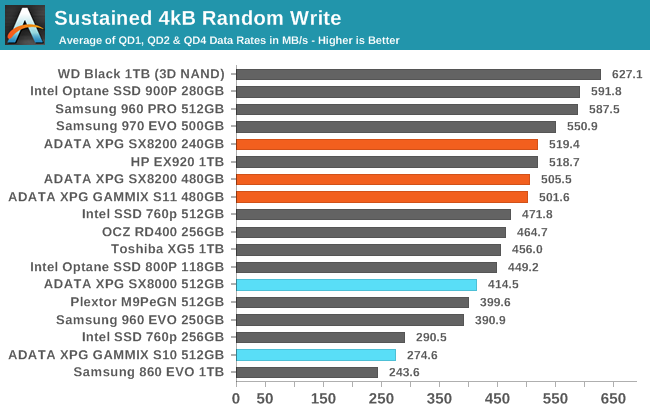
On the longer random read test, the newer ADATA drives aren't quite as close to the top of the charts, but they are still performing very well and are far faster than their predecessors.
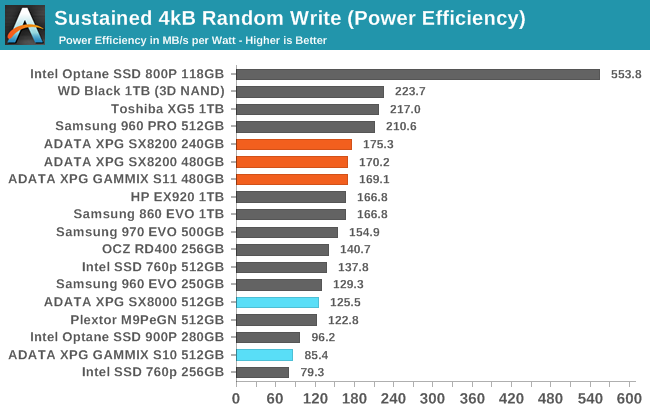 |
|||||||||
| Power Efficiency in MB/s/W | Average Power in W | ||||||||
The power efficiency of the SX8200 and GAMMIX S11 on the sustained random write test puts them in the second tier of flash-based SSDs, with just two TLC-based drives producing higher efficiency scores. The previous generation of ADATA NVMe SSDs draw more power and deliver worse performance.
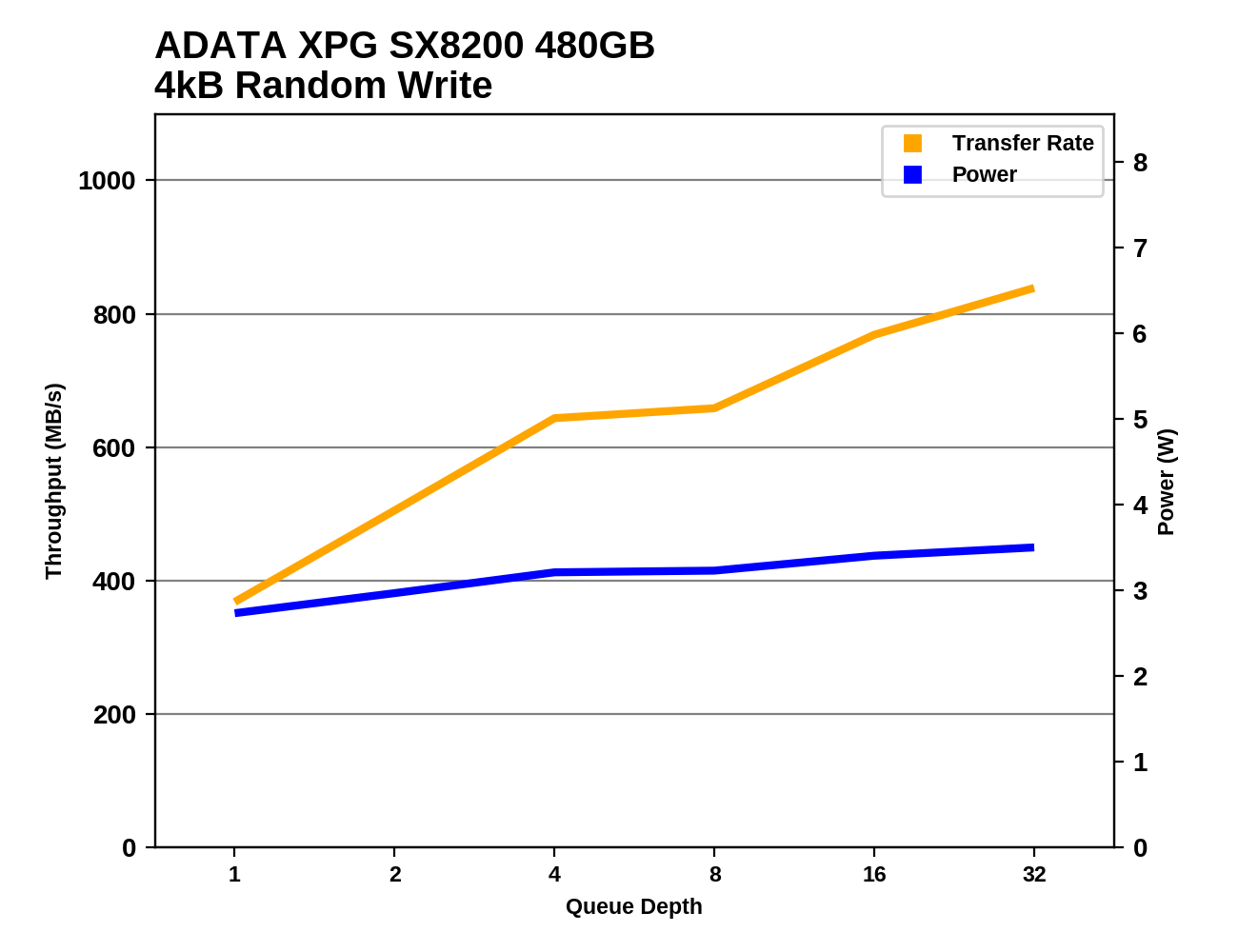 |
|||||||||
Where the GAMMIX S10 hit a performance plateau quite early and the SX8000 spent most of the random write test dealing with rough garbage collection cycles, the SX8200 keeps improving performance as queue depths increase. The 240GB SX8200 does lose performance during part of the random write test due to the SLC cache filling up, but it doesn't drop below the QD1 throughput and it recovers before the end of the test.
Sequential Read Performance
Our first test of sequential read performance uses short bursts of 128MB, issued as 128kB operations with no queuing. The test averages performance across eight bursts for a total of 1GB of data transferred from a drive containing 16GB of data. Between each burst the drive is given enough idle time to keep the overall duty cycle at 20%.

The burst sequential read performance of the ADATA XPG SX8200 and GAMMIX S11 is the exact opposite of how their predecessors behave. The newer drives provide the same fast performance we saw with the 1TB HP EX920, while the older drives are at the very bottom of the chart with only 15-20% the throughput of the SX8200.
Our test of sustained sequential reads uses queue depths from 1 to 32, with the performance and power scores computed as the average of QD1, QD2 and QD4. Each queue depth is tested for up to one minute or 32GB transferred, from a drive containing 64GB of data. This test is run twice: once with the drive prepared by sequentially writing the test data, and again after the random write test has mixed things up, causing fragmentation inside the SSD that isn't visible to the OS. These two scores represent the two extremes of how the drive would perform under real-world usage, where wear leveling and modifications to some existing data will create some internal fragmentation that degrades performance, but usually not to the extent shown here.
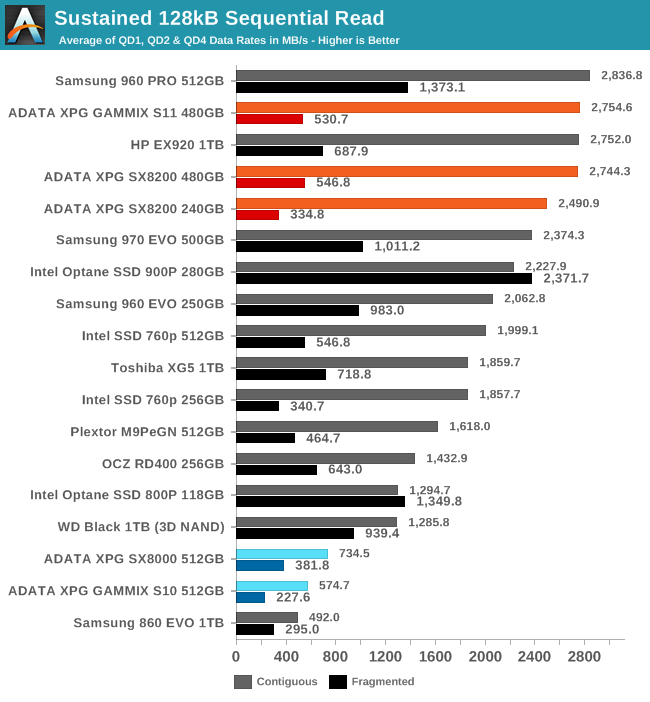
On the longer sequential read test, the SM2262 drives continue to dominate, but we find that they do not handle internal fragmentation as well as most other TLC drives. They lose proportionally more performance as a result of the fragmentation, but don't fall far behind the competition.
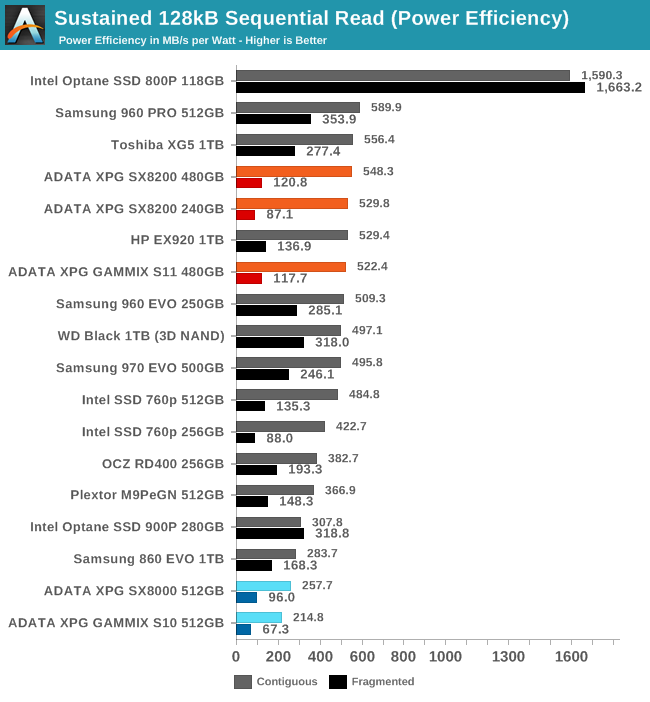 |
|||||||||
| Power Efficiency in MB/s/W | Average Power in W | ||||||||
The power consumption of the SX8200 and GAMMIX S11 during the sustained sequential read test is a bit on the high side, but it's more than offset by the high performance, giving the drives some of the highest efficiency scores possible with flash memory.
 |
|||||||||
The SX8200 and GAMMIX S11 hit full sequential read speeds at QD2, and sustain them for the rest of the test. The 240GB model saturates at around 2.7-2.8GB/s while the 480GB drives match the 1TB HP EX920 in delivering about 3.2GB/s.
Sequential Write Performance
Our test of sequential write burst performance is structured identically to the sequential read burst performance test save for the direction of the data transfer. Each burst writes 128MB as 128kB operations issued at QD1, for a total of 1GB of data written to a drive containing 16GB of data.
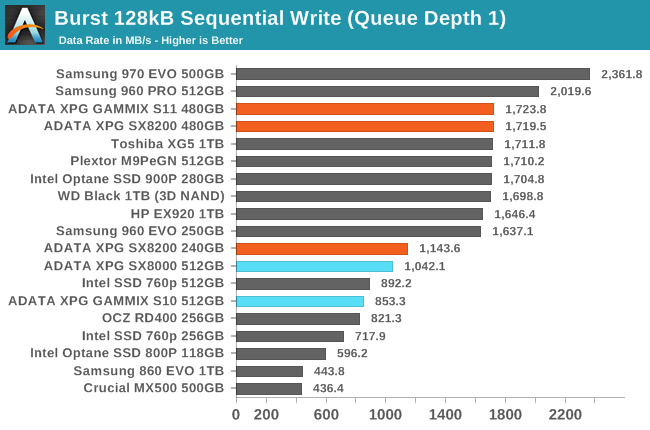
The burst sequential write speed of the 240GB ADATA XPG SX8200 is substantially lower than the excellent performance that the larger capacity manages, but both capacities are meeting their advertised performance specifications.
Our test of sustained sequential writes is structured identically to our sustained sequential read test, save for the direction of the data transfers. Queue depths range from 1 to 32 and each queue depth is tested for up to one minute or 32GB, followed by up to one minute of idle time for the drive to cool off and perform garbage collection. The test is confined to a 64GB span of the drive.

On the longer sequential write test, the 480GB SX8200 and GAMMIX S11 lose a bit of performance and drop slightly in the rankings, but the 240GB barely loses any performance. The drives are very competitive against other products from this generation, and put their predecessors to shame.
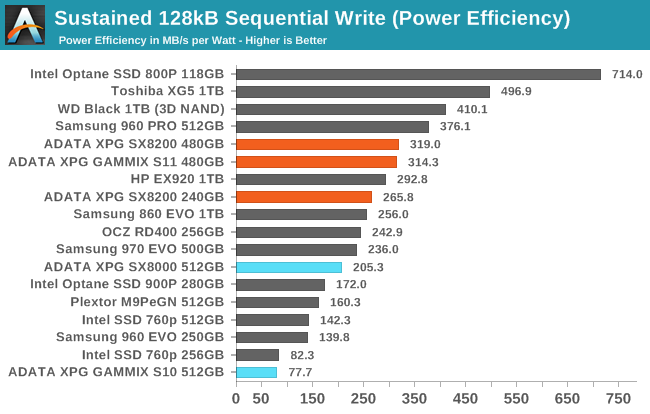 |
|||||||||
| Power Efficiency in MB/s/W | Average Power in W | ||||||||
The SX8200 doesn't set any power efficiency records, but it remains close to the top of the chart. Total power consumption is similar to other NVMe SSDs, so the efficiency scores are mostly proportional to performance.
 |
|||||||||
The SX8200 hits full sequential write speed at QD2, though for the 240GB model this is barely an increase over QD1 performance. Performance remains steady for the rest of the test, with no obvious signs of garbage collection stalling the SSD.
Mixed Random Performance
Our test of mixed random reads and writes covers mixes varying from pure reads to pure writes at 10% increments. Each mix is tested for up to 1 minute or 32GB of data transferred. The test is conducted with a queue depth of 4, and is limited to a 64GB span of the drive. In between each mix, the drive is given idle time of up to one minute so that the overall duty cycle is 50%.
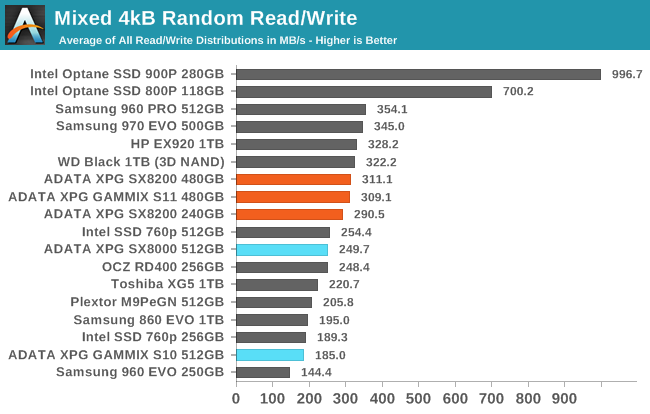
The mixed random I/O performance of the ADATA XPG SX8200 and GAMMIX S11 is a little bit slower than the fastest flash-based SSDs, but is still quite fast, especially given the lower drive capacities.
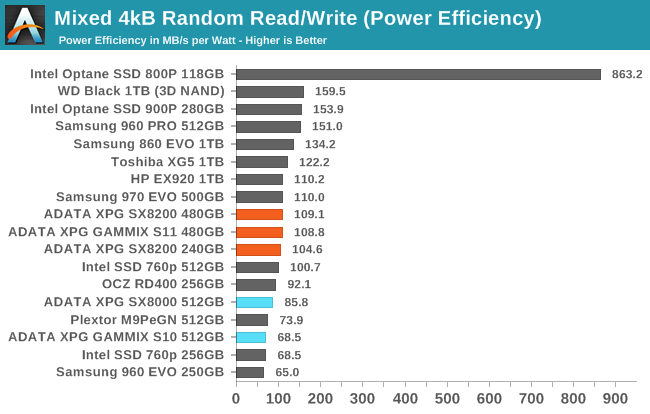 |
|||||||||
| Power Efficiency in MB/s/W | Average Power in W | ||||||||
The power efficiency of the SX8200 is about par, a product of above-average performance combined with slightly above average power draw.
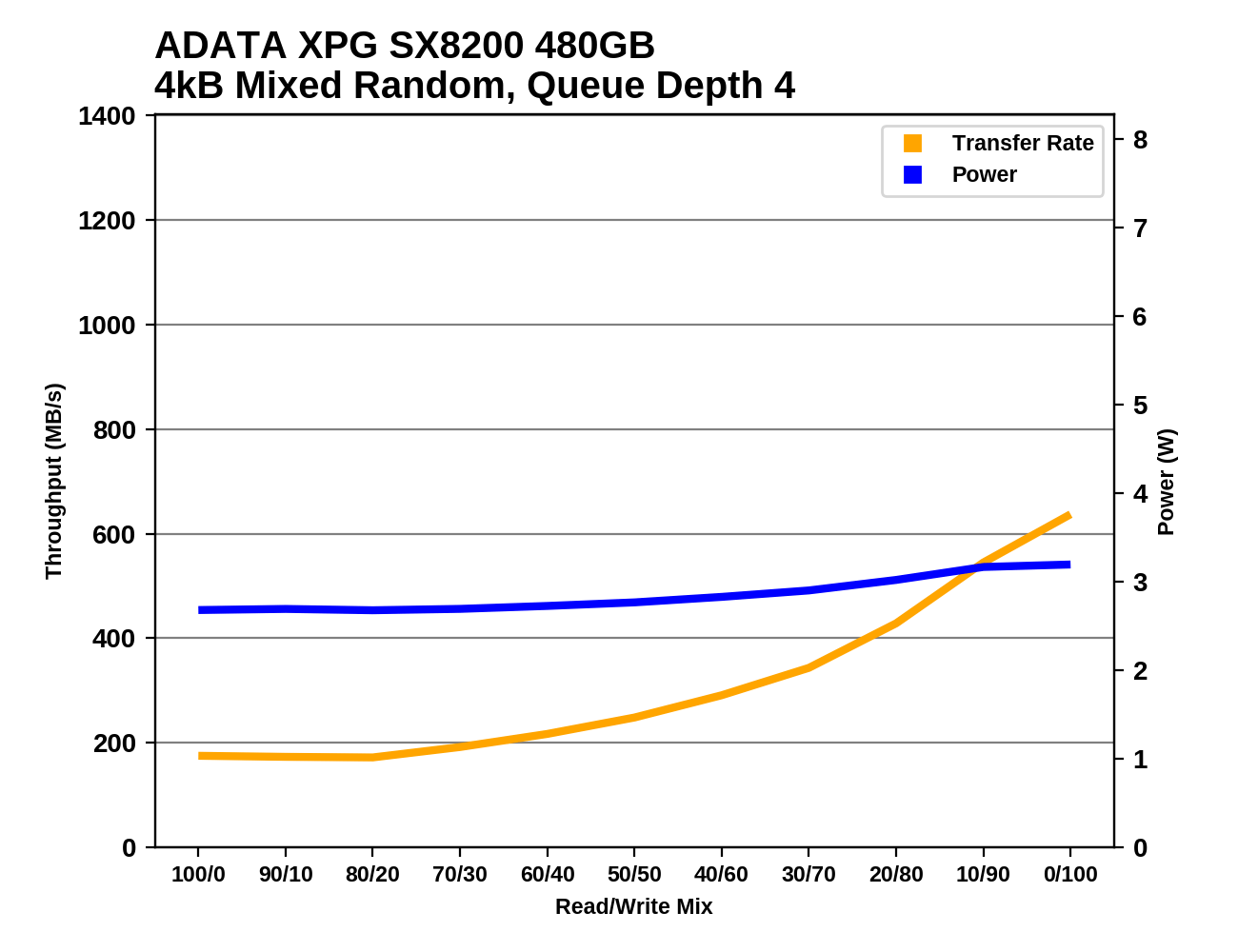 |
|||||||||
The ADATA XPG SX8200's performance during the mixed random I/O test starts off fairly flat with little impact from a few writes being added to the mix. As the portion of writes increases, the SX8200's performance accelerated to end up with very good performance near the end of the test. However, in the final phase when the workload shifts to pure writes, the SX8200 doesn't show as pronounced a spike in performance as is typical for high-end SSDs.
Mixed Sequential Performance
Our test of mixed sequential reads and writes differs from the mixed random I/O test by performing 128kB sequential accesses rather than 4kB accesses at random locations, and the sequential test is conducted at queue depth 1. The range of mixes tested is the same, and the timing and limits on data transfers are also the same as above.

The SM2262 drives including the newer generation from ADATA cannot quite match the performance of the best from Samsung or WD on the mixed sequential workload test, but they otherwise perform quite well for their capacity, and are about twice as fast as the older SX8000.
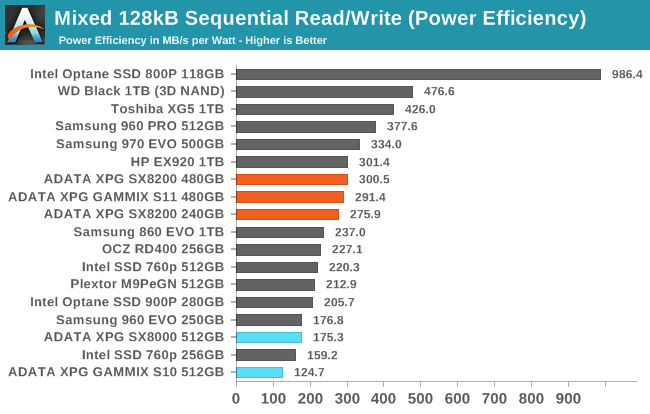 |
|||||||||
| Power Efficiency in MB/s/W | Average Power in W | ||||||||
The average power consumption of the SX8200 during the mixed sequential I/O test is rather high at about 4W compared to 3W for the preceding generation drives. However, the performance increase is more than enough to justify the power increase, and overall power efficiency is pretty good.
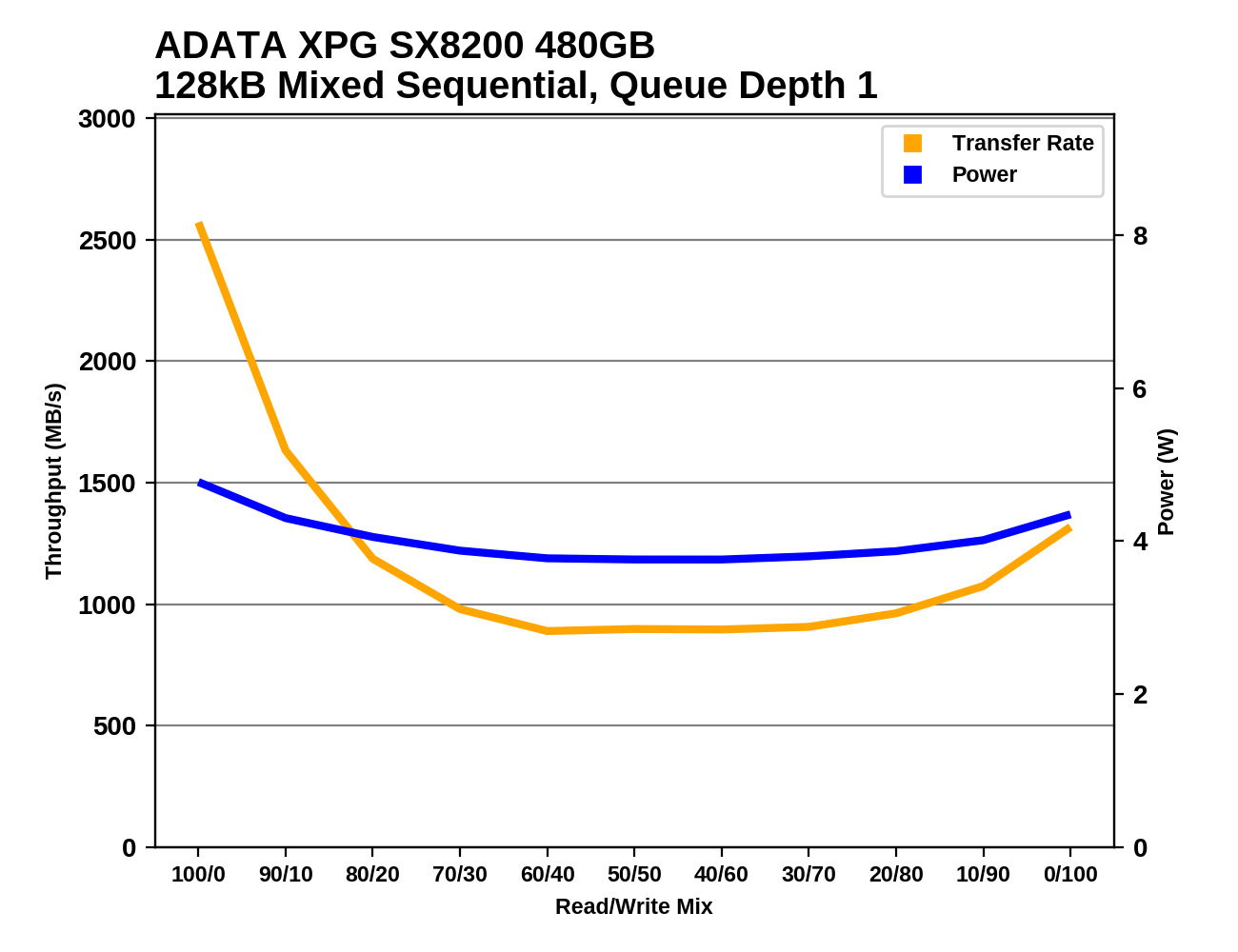 |
|||||||||
The performance of the SX8200 during the mixed sequential I/O test exhibits a classic bathtub curve, with a steep decline as writes are first introduced, very flat performance through the middle of the test with a minimum in the 7-800 MB/s range, and a bit of a performance rebound at the end of the test. Most other drives in this class aren't quite as consistent through the middle of the test and tend to continue slowly losing performance until turning around in the second half.
Power Management Features
Real-world client storage workloads leave SSDs idle most of the time, so the active power measurements presented earlier in this review only account for a small part of what determines a drive's suitability for battery-powered use. Especially under light use, the power efficiency of a SSD is determined mostly be how well it can save power when idle.
For many NVMe SSDs, the closely related matter of thermal management can also be important. M.2 SSDs can concentrate a lot of power in a very small space. They may also be used in locations with high ambient temperatures and poor cooling, such as tucked under a GPU on a desktop motherboard, or in a poorly-ventilated notebook.
| ADATA XPG SX8200 and GAMMIX S11 NVMe Power and Thermal Management Features |
|||
| Controller | Silicon Motion SM2262 | ||
| Firmware | SX8200: SVN105 GAMMIX S11: SVN139B |
||
| NVMe Version |
Feature | Status | |
| 1.0 | Number of operational (active) power states | 3 | |
| 1.1 | Number of non-operational (idle) power states | 2 | |
| Autonomous Power State Transition (APST) | Supported | ||
| 1.2 | Warning Temperature | 70 °C | |
| Critical Temperature | 80 °C | ||
| 1.3 | Host Controlled Thermal Management | Supported | |
| Non-Operational Power State Permissive Mode | Not Supported | ||
Our samples of the ADATA XPG SX8200 use an older firmware revision than the GAMMIX S11 sample, but the power and thermal management features are the same between the two versions. ADATA's first generation of NVMe drives using the SM2260 controller didn't support Autonomous Power State Transitions, so in practice their idle power states would usually go completely unused. The warning and critical temperature thresholds are also 8 °C higher than on the SX8000.
The new drives with the SM2262 controller not only make the idle power states usable out of the box with most operating systems, they have significantly improved those idle power states: PS3 consumption has gone from 70mW to 45mW and the transition latencies are about an order of magnitude faster. (The SX7000/GAMMIX S10 firmware actually advertised even faster transitions, but without APST support that hardly matters.)
| ADATA XPG SX8200 and GAMMIX S11 NVMe Power States |
|||||
| Controller | Silicon Motion SM2262 | ||||
| Firmware | SX8200: SVN105 GAMMIX S11: SVN139B |
||||
| Power State |
Maximum Power |
Active/Idle | Entry Latency |
Exit Latency |
|
| PS 0 | 9 W | Active | - | - | |
| PS 1 | 4.6 W | Active | - | - | |
| PS 2 | 3.8 W | Active | - | - | |
| PS 3 | 45 mW | Idle | 2 ms | 2 ms | |
| PS 4 | 4 mW | Idle | 6 ms | 8 ms | |
Note that the above tables reflect only the information provided by the drive to the OS. The power and latency numbers are often very conservative estimates, but they are what the OS uses to determine which idle states to use and how long to wait before dropping to a deeper idle state.
Idle Power Measurement
SATA SSDs are tested with SATA link power management disabled to measure their active idle power draw, and with it enabled for the deeper idle power consumption score and the idle wake-up latency test. Our testbed, like any ordinary desktop system, cannot trigger the deepest DevSleep idle state.
Idle power management for NVMe SSDs is far more complicated than for SATA SSDs. NVMe SSDs can support several different idle power states, and through the Autonomous Power State Transition (APST) feature the operating system can set a drive's policy for when to drop down to a lower power state. There is typically a tradeoff in that lower-power states take longer to enter and wake up from, so the choice about what power states to use may differ for desktop and notebooks.
We report two idle power measurements. Active idle is representative of a typical desktop, where none of the advanced PCIe link or NVMe power saving features are enabled and the drive is immediately ready to process new commands. The idle power consumption metric is measured with PCIe Active State Power Management L1.2 state enabled and NVMe APST enabled if supported.
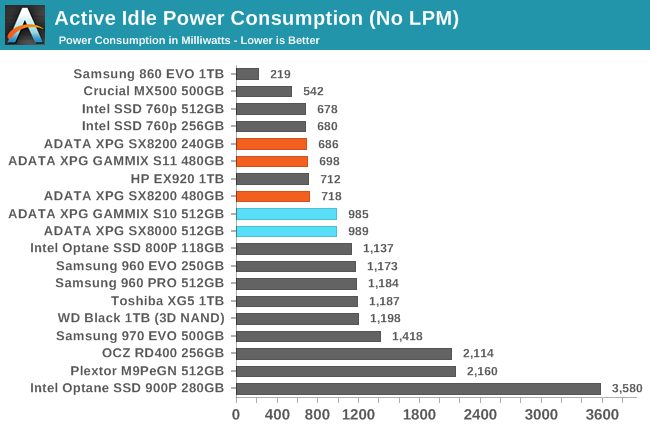
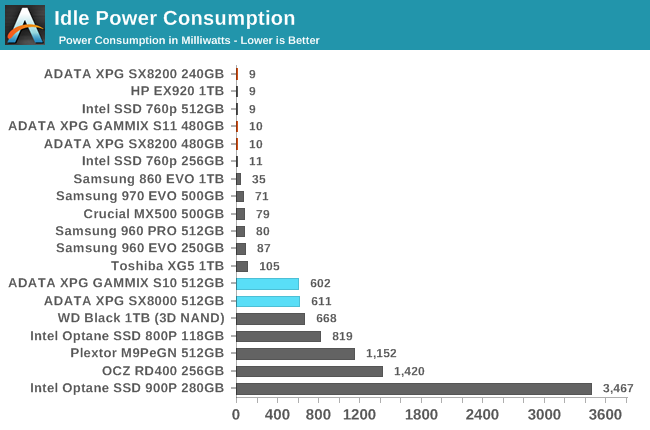
The active idle power consumption of the ADATA SX8200 and GAMMIX S11 is in line with other SM2262 SSDs, and about 30% lower than the SM2260-based predecessors. Thanks to the addition of NVMe APST support, the newer drives actually get to use their deepest idle states, putting them around 10mW compared to the 600+ mW used by their predecessors.

Now that deep sleep states are actually being used, it's a given that the newer ADATA drives have non-trivial wake-up latencies. The SX8200 and GAMMIX S11 are relatively slow to wake up compared to the drives that idle in the 70-100mW range instead of the 10mW we get from the SM2262. However, the new ADATA drives are about 10ms faster to wake up than the other SM2262 drives we've tested.
Conclusion
The ADATA XPG SX8200 and GAMMIX S11 provide more evidence that Silicon Motion's latest NVMe SSD controller is a winner. The excellent performance we got from the 1TB HP EX920 doesn't require that high of a capacity—the 480GB ADATA drives tested here are never far behind, and the 240GB SX8200 is a bit slower on several tests but is still very fast overall. ADATA made the right choice by not including a 120GB model in the SX8200 family. A 120GB model would not have been able to perform adequately for this class of product.
The SX8200 and GAMMIX S11 represent a huge advance over their predecessors. The SX8000, SX7000 and GAMMIX S10 used Silicon Motion's first NVMe controller, which proved to be inadequate for powering a high-end SSD, but it was the best option ADATA had at the time. With the new generation of SSD controllers and 3D NAND flash, ADATA is finally able to hit their performance goals and deliver a competitive premium NVMe SSD.
ADATA hasn't done much to differentiate the SX8200 and GAMMIX S11 from each other or from other SM2262 drives on the market. The heatspreaders provide mostly cosmetic value while the functional aspects of the drive sticks to Silicon Motion's reference design. The great results we've been getting from these reference designs calls into question Intel's custom firmware for the 760p. The 760p is by no means always slower than drives like the SX8200 or HP EX920, but overall the reference firmware seems to offer the better balance of performance for most users. Intel's close relationship with Silicon Motion sometimes gives them a distinct advantage, but in this case it seems like the 760p may have been released a little too early.
| NVMe SSD Price Comparison | |||
| 240-280GB | 480-512GB | 960GB-1TB | |
| ADATA XPG SX8200 | $91.93 (38¢/GB) |
$139.99 (29¢/GB) | $284.99 (30¢/GB) |
| ADATA XPG GAMMIX S11 | $84.99 (35¢/GB) |
$159.99 (33¢/GB) | $299.99 (31¢/GB) |
| ADATA XPG SX6000 | $62.99 (25¢/GB) | $114.99 (22¢/GB) | |
| ADATA XPG SX8000 | $94.99 (37¢/GB) |
$144.99 (28¢/GB) | $561.25 (55¢/GB) |
| ADATA XPG GAMMIX S10 | $74.99 (29¢/GB) |
$129.99 (25¢/GB) | $467.13 (46¢/GB) |
| HP EX920 | $108.89 (43¢/GB) | $179.95 (35¢/GB) | $297.96 (29¢/GB) |
| Intel SSD 760p | $84.99 (33¢/GB) |
$157.00 (31¢/GB) | $319.99 (31¢/GB) |
| MyDigitalSSD SBX | $69.99 (27¢/GB) | $139.99 (27¢/GB) | $299.99 (29¢/GB) |
| Western Digital WD Black (2018) | $99.99 (40¢/GB) |
$179.99 (36¢/GB) | $379.99 (38¢/GB) |
| Samsung 970 EVO | $106.99 (43¢/GB) | $197.97 (40¢/GB) | $389.99 (39¢/GB) |
| Samsung 970 PRO | |||
| Intel Optane SSD 900P | |||
| Intel Optane SSD 905P | |||
With few functional differences from other SM2262 drives on the market, ADATA has to compete almost solely on price. They seem to be doing a good job of that. The XPG GAMMIX S11 is generally a bit more expensive than the SX8200, but at the moment supplies of the 240GB SX8200 seem to be limited and the GAMMIX S11 is actually slightly cheaper. The HP EX920 is a slightly better value at 1TB, but for lower capacities either ADATA drive wins. The ADATA SX8200 is also barely more expensive than the MyDigitalSSD SBX, one of the more competitively-priced low-end NVMe SSDs. ADATA's own SX6000 low-end NVMe SSD is even cheaper and closer to SATA pricing, but it comes with pretty serious performance compromises and a relatively unproven Realtek controller.
With even the smallest SX8200 turning in some of the highest scores on our AnandTech Storage Bench tests of real-world I/O patterns, it's quite difficult to make a case for the more expensive drives like the Western Digital WD Black and the Samsung 970 EVO, let alone the 970 PRO. The WD Black still provides a unique combination of performance and power efficiency, but for desktop users its advantages aren't worth the price premium. The 970 EVO offers better performance on some real-world workloads, but for the vast majority of users who don't have a workload that's anywhere near as intense as The Destroyer, the 970 EVO's performance advantages won't be realized.

